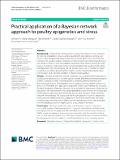Files in this item
Practical application of a Bayesian network approach to poultry epigenetics and stress
Item metadata
| dc.contributor.author | Videla Rodriguez, Emiliano Ariel | |
| dc.contributor.author | Pértille, Fábio | |
| dc.contributor.author | Guerrero-Bosagna, Carlos | |
| dc.contributor.author | Mitchell, John B. O. | |
| dc.contributor.author | Jensen, Per | |
| dc.contributor.author | Smith, V.A. | |
| dc.date.accessioned | 2022-07-05T11:30:19Z | |
| dc.date.available | 2022-07-05T11:30:19Z | |
| dc.date.issued | 2022-07-01 | |
| dc.identifier | 280080945 | |
| dc.identifier | 0de66858-d77f-4be8-a860-29a71ef1a078 | |
| dc.identifier | 85133345306 | |
| dc.identifier | 000820481200002 | |
| dc.identifier.citation | Videla Rodriguez , E A , Pértille , F , Guerrero-Bosagna , C , Mitchell , J B O , Jensen , P & Smith , V A 2022 , ' Practical application of a Bayesian network approach to poultry epigenetics and stress ' , BMC Bioinformatics , vol. 23 , 261 . https://doi.org/10.1186/s12859-022-04800-0 | en |
| dc.identifier.issn | 1471-2105 | |
| dc.identifier.other | ORCID: /0000-0002-0487-2469/work/115631092 | |
| dc.identifier.other | ORCID: /0000-0002-0379-6097/work/115631189 | |
| dc.identifier.uri | https://hdl.handle.net/10023/25604 | |
| dc.description | This work was supported by the European Union’s Horizon 2020 research and innovation programme under the Marie Skłodowska-Curie grant agreement No 812777. We also greatly appreciate funding from the Swedish Research Council for Environment, Agricultural Sciences and Spatial Planning (FORMAS) grants #2018-01074 and #2017-00946 to CG-B. FP appreciates funding from São Paulo Research Foundation (FAPESP, Brazil) projects #2016/20440-3 and #2018/13600-0. | en |
| dc.description.abstract | Background: Relationships among genetic or epigenetic features can be explored by learning probabilistic networks and unravelling the dependencies among a set of given genetic/epigenetic features. Bayesian networks (BNs) consist of nodes that represent the variables and arcs that represent the probabilistic relationships between the variables. However, practical guidance on how to make choices among the wide array of possibilities in Bayesian network analysis is limited. Our study aimed to apply a BN approach, while clearly laying out our analysis choices as an example for future researchers, in order to provide further insights into the relationships among epigenetic features and a stressful condition in chickens (Gallus gallus). Results: Chickens raised under control conditions (n = 22) and chickens exposed to a social isolation protocol (n = 24) were used to identify differentially methylated regions (DMRs). A total of 60 DMRs were selected by a threshold, after bioinformatic pre-processing and analysis. The treatment was included as a binary variable (control = 0; stress = 1). Thereafter, a BN approach was applied: initially, a pre-filtering test was used for identifying pairs of features that must not be included in the process of learning the structure of the network; then, the average probability values for each arc of being part of the network were calculated; and finally, the arcs that were part of the consensus network were selected. The structure of the BN consisted of 47 out of 61 features (60 DMRs and the stressful condition), displaying 43 functional relationships. The stress condition was connected to two DMRs, one of them playing a role in tight and adhesive intracellular junctions in organs such as ovary, intestine, and brain. Conclusions: We clearly explain our steps in making each analysis choice, from discrete BN models to final generation of a consensus network from multiple model averaging searches. The epigenetic BN unravelled functional relationships among the DMRs, as well as epigenetic features in close association with the stressful condition the chickens were exposed to. The DMRs interacting with the stress condition could be further explored in future studies as possible biomarkers of stress in poultry species. | |
| dc.format.extent | 16 | |
| dc.format.extent | 1829819 | |
| dc.language.iso | eng | |
| dc.relation.ispartof | BMC Bioinformatics | en |
| dc.subject | Bayesian networks | en |
| dc.subject | Differential methylation | en |
| dc.subject | Epigenetics | en |
| dc.subject | Poultry | en |
| dc.subject | Stress | en |
| dc.subject | QA75 Electronic computers. Computer science | en |
| dc.subject | QH426 Genetics | en |
| dc.subject | DAS | en |
| dc.subject.lcc | QA75 | en |
| dc.subject.lcc | QH426 | en |
| dc.title | Practical application of a Bayesian network approach to poultry epigenetics and stress | en |
| dc.type | Journal article | en |
| dc.contributor.sponsor | European Commission | en |
| dc.contributor.institution | University of St Andrews. School of Biology | en |
| dc.contributor.institution | University of St Andrews. EaSTCHEM | en |
| dc.contributor.institution | University of St Andrews. Biomedical Sciences Research Complex | en |
| dc.contributor.institution | University of St Andrews. School of Chemistry | en |
| dc.contributor.institution | University of St Andrews. St Andrews Bioinformatics Unit | en |
| dc.contributor.institution | University of St Andrews. Office of the Principal | en |
| dc.contributor.institution | University of St Andrews. St Andrews Centre for Exoplanet Science | en |
| dc.contributor.institution | University of St Andrews. Centre for Biological Diversity | en |
| dc.contributor.institution | University of St Andrews. Scottish Oceans Institute | en |
| dc.contributor.institution | University of St Andrews. Institute of Behavioural and Neural Sciences | en |
| dc.identifier.doi | https://doi.org/10.1186/s12859-022-04800-0 | |
| dc.description.status | Peer reviewed | en |
| dc.identifier.grantnumber | 812777 | en |
This item appears in the following Collection(s)
Items in the St Andrews Research Repository are protected by copyright, with all rights reserved, unless otherwise indicated.

